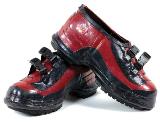Selecting Dielectric Footwear


Electrical workers exposed to high-voltage need complete protection including dielectric footwear. While rubber insulating gloves provide primary protection against shock hazards, dielectric footwear provides secondary protection from step-and-touch potential in the entire work zone, not just the confined work area. Dielectric footwear is used where there is a risk of electric shock from high voltage.
ASTM Standard Dielectric Footwear

ASTM tested footwear products are INSULATING shoes and boots. ASTM has two related standard specifications for dielectric footwear. ASTM F1116 is a test method for determining the dielectric strength of dielectric footwear. Testing is done over the maximum possible area of the dielectric footwear without permitting flashover between electrodes. ASTM F1117 is the actual standard specification for dielectric footwear and utilizes the test method in ASTM F1116 and covers both over-the-sock and overshoe dielectric footwear. A key provision in ASTM F1117 is that 100% of the dielectric footwear products must pass dielectric testing for one to three minutes at the rated voltage which is usually 20,000 volts AC although the standard includes lower-rated footwear tested at 15,000 volts AC. DC test values are included in the ASTM standards.
EH Rated Footwear
Electrical hazard (EH) rated safety boots and shoes are ISOLATING safety boots rather than INSULATING safety footwear. The general protective footwear standard, ASTM F2413, uses a test method in ASTM F2412. That means that EH rated footwear is made from non-conductive materials. Only the outsole and heel of EH rated footwear are tested to withstand the rated voltage for one minute without failure or current flow or leakage current exceeding one milliampere under dry conditions. The ASTM F2413 standard covers required testing and rating for impact resistance (I) and compression resistance (C). Optional ASTM F2413 tests include electric hazard protection (EH), metatarsal protection (Mt), conductive protection (Cd), static dissipative protection (SD) and puncture resistance (PR).
Overshoe vs. Over-the-foot
 Both footwear standards include quality products that can be worn over workshoes or over-the-foot. While ASTM F2413 EH-rated footwear includes ratings for at least impact and compression resistance, ASTM F1117 rated footwear is generally accepted as a higher-level dielectric test and standard. For maximum protection, many ASTM F1117 footwear products can be worn over standard work shoes and boots adding electric insulating properties to impact and compression and often puncture protection.
Both footwear standards include quality products that can be worn over workshoes or over-the-foot. While ASTM F2413 EH-rated footwear includes ratings for at least impact and compression resistance, ASTM F1117 rated footwear is generally accepted as a higher-level dielectric test and standard. For maximum protection, many ASTM F1117 footwear products can be worn over standard work shoes and boots adding electric insulating properties to impact and compression and often puncture protection.
Select Product According to Hazard
The key, as always, is to evaluate the hazard, the work conditions, and the exposure and then select products accordingly. Where the physical hazards require protection against impact and compression with only limited exposure to possible electrical hazards, ASTM F2413-rated footwear with the mandatory C and I ratings plus EH rating may be suitable. However, utility linemen often work with their feet deep in mud, water, tall grass, and other conditions where the hazard exposure could be above the sole and heel. That is why ASTM F1116 and F1117 standards were developed – to deliver a higher level of electrical insulating protection.
Daily Work Practices
As always, personal protective equipment should be inspected at the start of every work shift and immediately after any event that may cause damage to the product and reduce safety. Treads and soles wear down with use and punctures and abrasion and cuts obviously reduce the protection. Although no ASTM or regulatory standard currently exists governing periodic laboratory inspection and dielectric testing of in-service footwear, many companies are requiring retesting on at least an annual basis.

